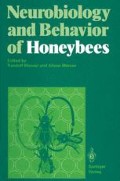Abstract
Several recent studies of the Asian honeybees, Apis florea, A. dorsata, and A. cerana, have greatly extended our understanding of dance orientation in honeybees. From early studies, the dances of A. florea and A. dorsata were thought to be somewhat primitive in comparison with those of the other species of Apis. Now it is clear that each exhibits capabilities of information processing that are no less sophisticated than any seen in A. cerana and in the European species, A. mellifera. Apis dorsata forages on moonlit nights, even by the light of a half moon, and performs waggle dances that are oriented not to the moon but instead apparently to the hidden sun. Apis florea, once thought to be capable of orienting dances only in the horizontal plane and in the presence of celestial cues, can actually orient without a view of the sun and blue sky by referring to landmarks visible from the exposed dance area. Furthermore, A. florea will dance on steep, even vertical, slopes. In such dances a bee continues to orient to the horizontal projections of celestial cues, instead of to their projections onto the plane on which she is dancing (as the other species do if presented with celestial cues during a vertical dance). In addition to raising a host of new questions about the mechanisms underlying the dances of A. florea and A. dorsata, these results challenge previous assumptions about the evolution of the dance language in Apis.
Access this chapter
Tax calculation will be finalised at checkout
Purchases are for personal use only
Preview
Unable to display preview. Download preview PDF.
References
Dyer, F.C. 1984. Comparative Studies of the Dance Language and Orientation of Four Species of Honey Bees. Ph.D. Thesis, Princeton University.
Dyer, F.C. 1985. Nocturnal orientation of the Asian honey bee, Apis dorsata. Anim. Behav. 33: 769–774.
Dyer, F.C. 1985. Mechanisms of dance orientation in the Asian honey bee, Apis florea. J. Comp. Physiol. A 157: 183–198.
Dyer, F.C., and Gould, J.L. 1981. Honey bee orientation: a backup system for cloudy days. Science 214: 1041–1042.
Dyer, F.C., and Seeley, T.D. 1987. Orientation and foraging in honey bees. In Insect Flight, eds. G.C. Goldsworthy and C.H. Wheeler. Cleveland, Ohio: CRC Press, in press.
Edrich, W. 1977. Interaction of light and gravity in the orientation of the waggle dance of honey bees. Anim. Behav. 25: 342–363.
Free, J.B. 1982. The biology and behaviour of the honeybee Apis florea. In Social Insects in the Tropics, ed. Free, J.B, pp. 181–187. Université Paris-Nord.
Frisch, K.v. 1967. The Dance Language and Orientation of Bees. Cambridge, Mass.: Belknap/Harvard.
Gould, J.L.; Dyer, F.C.; and Towne, W.F. 1985. Recent progress in the study of the dance language. Fort sehr. Zool. 31: 141–161.
Koeniger, N. 1976. Neue Aspekte der Phylogenie innerhalb der Gattung Apis. Apidologie 7: 357–366.
Koeniger, N., and Koeniger, G. 1980. Observations and experiments on migration and dance communication of Apis dorsata in Sri Lanka. J. Apic. Res. 19: 21–34.
Koeniger, N.; Koeniger, G.; Punchihewa, R.K.W.; Fabritius, Mo.; and Fabritius, Mi. 1982. Observations and experiments on dance communication of Apis florea in Sri Lanka. J. Apic. Res. 21: 45–52.
Lindauer, M. 1956. Über die Verständigung bei indischen Bienen. Z. vergl. Physiol. 38: 521–557.
Lindauer, M. 1961. Communication Among Social Bees. Cambridge, Mass.: Belknap/Harvard.
Sakagami, S.F. 1971. Ethosoziologischer Vergleich zwischen Honigbienen und stachellosen Bienen. Z. Tierpsychol. 28: 337–350.
Seeley, T.D.; Seeley, R.H.; and Akratanakul, P. 1982. Colony defense strategies of the honey bees in Thailand. Ecol. Monogr. 52: 43–63.
Winston, M.L., and Michener, C.D. 1977. Dual origin of highly social behavior among bees. Proc. Nat. Acad. Sci. USA 74: 1135–1137.
Author information
Authors and Affiliations
Editor information
Editors and Affiliations
Rights and permissions
Copyright information
© 1987 Springer-Verlag Berlin Heildelberg
About this paper
Cite this paper
Dyer, F.C. (1987). New Perspectives on the Dance Orientation of the Asian Honeybees. In: Menzel, R., Mercer, A. (eds) Neurobiology and Behavior of Honeybees. Springer, Berlin, Heidelberg. https://doi.org/10.1007/978-3-642-71496-2_5
Download citation
DOI: https://doi.org/10.1007/978-3-642-71496-2_5
Publisher Name: Springer, Berlin, Heidelberg
Print ISBN: 978-3-642-71498-6
Online ISBN: 978-3-642-71496-2
eBook Packages: Springer Book Archive

